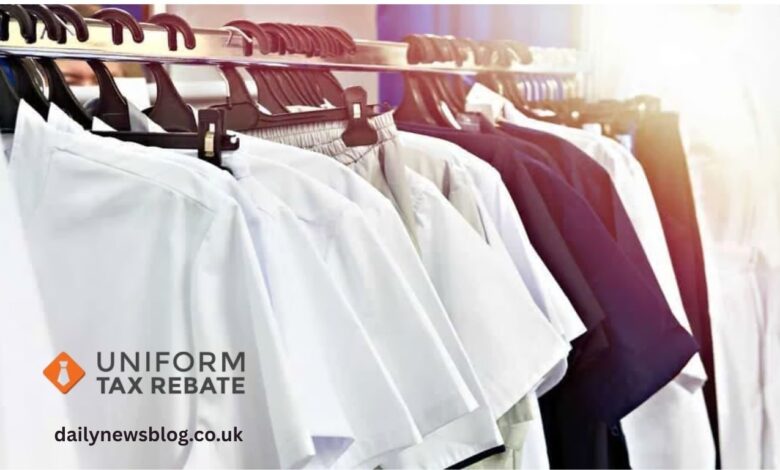Tax Office Uniform Rebate: Don’t Miss This Deadline

If you wear a uniform to work and are responsible for its upkeep, you could be entitled to a Tax Office Uniform Rebate—a valuable but often overlooked benefit. Many workers are unaware that the costs of washing, repairing, or even replacing their uniform can be partially reclaimed through tax relief. Whether you work in retail, healthcare, or a skilled trade, this article will guide you through everything you need to know about claiming your rebate before the deadline.
What Is a Tax Office Uniform Rebate?
The Tax Office Uniform Rebate is a form of tax relief that allows employees to recover money spent on maintaining work uniforms. It applies to any employee who is required to wear a specific uniform as part of their job and who must personally pay for cleaning or repairs.
The rebate is usually offered by national tax authorities like HMRC in the UK or the ATO in Australia. It’s not just limited to physical laborers either—anyone from dental assistants to retail clerks may be eligible, provided the uniform identifies their job and meets uniform rebate guidelines.
This tax benefit is especially important in industries where uniforms require frequent washing or where professional appearance is part of the job. Over time, these costs add up, and the rebate can help relieve that financial burden.
Who Is Eligible for a Tax Office Uniform Rebate?
Qualifying Occupations and Situations
If you’re unsure whether you qualify, consider the following criteria:
- You wear a uniform that displays a company logo or distinctive design
- Your employer does not offer cleaning or maintenance services
- You pay for these services out of pocket
- You are subject to income tax in your country
Eligibility is not restricted to any one sector. Millions of workers unknowingly qualify. Those in the military, healthcare, law enforcement, hospitality, aviation, postal services, and many other sectors commonly miss out simply because they’re unaware of the rebate’s existence.
What Counts as a Uniform?
A “uniform” is not necessarily a full outfit. It may consist of:
- A shirt or blouse with a company logo
- Safety gear like high-visibility vests or steel-toe boots
- Protective clothing is required by health and safety laws
- Any workwear mandated by your employer that cannot be worn as everyday clothing
Casual clothes or business suits typically do not count—unless they are explicitly required and branded for work use.
What Expenses Can You Claim?
Qualifying Costs Under the Rebate
The most common expenses covered under the Tax Office Uniform Rebate include:
- Regular washing and drying of your work clothes
- Ironing or dry cleaning costs (if required)
- Repairs such as stitching, button replacement, or hemming
- Replacement of damaged items, especially safety gear
If you use your home washer and dryer, the rebate assumes a standard cost for electricity, water, and detergent. You don’t need to submit receipts for these minor domestic expenses if claiming the flat-rate option.
How Much Can You Get from the Tax Office Uniform Rebate?
Flat-Rate vs. Itemized Claims
The flat-rate Tax Office Uniform Rebate varies depending on your profession. Some common examples:
- Nurses: £125 annually
- Mechanics: £140–£180 annually
- Police officers: Up to £140 annually
- Flight attendants: Around £80 annually
If your actual expenses exceed the flat rate (for example, if you use professional dry cleaning), you can claim the actual amount spent. However, this option requires supporting documentation such as invoices, receipts, and a detailed log.
Backdated Claims: Reclaim Up to 4 Years
One of the biggest advantages of the rebate is that you can backdate your claim up to four years, which means you might receive a lump sum refund. A nurse who hasn’t claimed for four years, for instance, could receive over £500—money they may never have realized was owed to them.
Step-by-Step Guide to Claiming Your Tax Office Uniform Rebate
Step 1 – Confirm Eligibility
First, ensure that your job meets the requirements:
- You are taxed through PAYE or self-assessment
- You wear a branded or required uniform
- You pay for its maintenance yourself
Step 2 – Decide on Flat Rate or Actual Cost
Most people opt for the flat-rate claim due to the ease of filing. However, if your expenses are significantly higher, the itemized option may yield a larger refund.
Step 3 – File Your Claim
You can claim the Tax Office Uniform Rebate online through your country’s tax office (e.g., HMRC). You’ll need:
- National Insurance number
- Employer details
- Evidence of employment
- Uniform policy or agreement
Step 4 – Wait for Refund and Update Records
After submission, it usually takes 4 to 8 weeks to receive your rebate. Be sure to update your tax code afterward, so future rebates are automatically reflected in your salary.
Can I Claim If I Changed Jobs or Employers?
Yes. If you wore a uniform and met eligibility requirements at a past job, you can still claim the rebate for those years. You’ll need to list your former employer and ensure you meet the rebate criteria for that period.
Common Mistakes to Avoid
- Assuming you’re not eligible
- Claiming for clothes that aren’t truly a uniform
- Forgetting to backdate the claim
- Failing to update your tax code
- Not including past jobs in your claim
Avoid these errors and you’ll have a much smoother rebate process.
Driving Test-Related FAQs for Broader Relevance
Where’s the easiest place to pass a driving test?
Rural test centres often have higher pass rates due to less traffic. Centres in quiet towns are statistically easier compared to urban centres like London or Birmingham.
How to fix error 15 DVSA?
This error occurs during online booking and typically points to a session timeout. Clear your browser cache or use a different browser. If issues persist, call the DVSA helpline.
What is the pass rate for the DVLA test centre?
Pass rates can vary from 35% to over 70%, depending on location. Visit the official DVSA website to view your local centre’s statistics.
Is the theory test 30 minutes?
The official time limit is 57 minutes, but most candidates finish in around 30 minutes.
What is the hardest part of the driving test?
The independent driving section, where you follow road signs without instructor input, and parallel parking are considered the most challenging.
Conclusion
Don’t let money slip through your fingers. The Tax Office Uniform Rebate is a legitimate way to reclaim part of your hard-earned cash. Whether you’re in healthcare, hospitality, or manual labor, you might be owed a tidy refund simply for doing what your job already requires.
By taking just 10–15 minutes to check your eligibility and submit a claim, you could receive a rebate worth hundreds of pounds, especially if you backdate it. Don’t delay and risk missing out on another year’s claim.
Act now—because the Tax Office Uniform Rebate deadline waits for no one.




